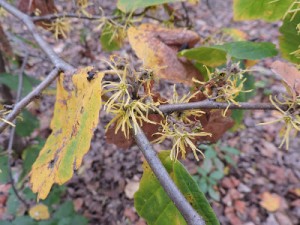The Interesting Natural History, Folklore of Witch Hazel
Published on October 28, 2015
Witch Hazel (Hamamelis virginiana) is a very common shrub in our region that is often overlooked. However, it has some interesting natural history and folklore associated with it. It also is calling attention to itself as one of the only woody plants to be in bloom this time of year. Each slightly aromatic flower consists of 4 slender twisted yellow petals which are often in bloom as its leaves change color or have even already dropped for the Fall. It is usually the last shrub to bloom, giving it one of its alternate names of “Winterbloom.”

Witch Hazel in Bloom
Since there are few pollinators available so late in the season, the flowers can self-pollinate and are not picky as to which pollinators make use of them. Often they are gnats or Noctuid moths, but quite a few have been noted. Each flower also lasts quite a long time giving potential pollinators ample time to find them.
Witch Hazel can reach 30′ in height, but rarely does so. It is usually an understory shrub, twisted in form. The seeds take a year to mature, with last years seed pods often still unopened next to the following year’s blossoms. It has an interesting seed dispersal mechanism, popping audibly and shooting the dark seeds up to 30′ feet away. This has led to such additional common names as Snapping Alder or Snapping Hazel. Once the seeds have been expelled, they commonly take two years to then germinate.
Although many magical qualities are associated with this plant, its common name of Witch Hazel is actually derived for different reasons. The “witch” part comes from older English word “wych” meaning “bendable” or “bending.” It looked similar enough to the European Wych Elm that the name was applied to the New World plants. This was later corrupted to “witch” but possibly because so many magical properties were also attributed to it.

Witch Hazel in Fall color
>> Read more at the Capital Naturalist.